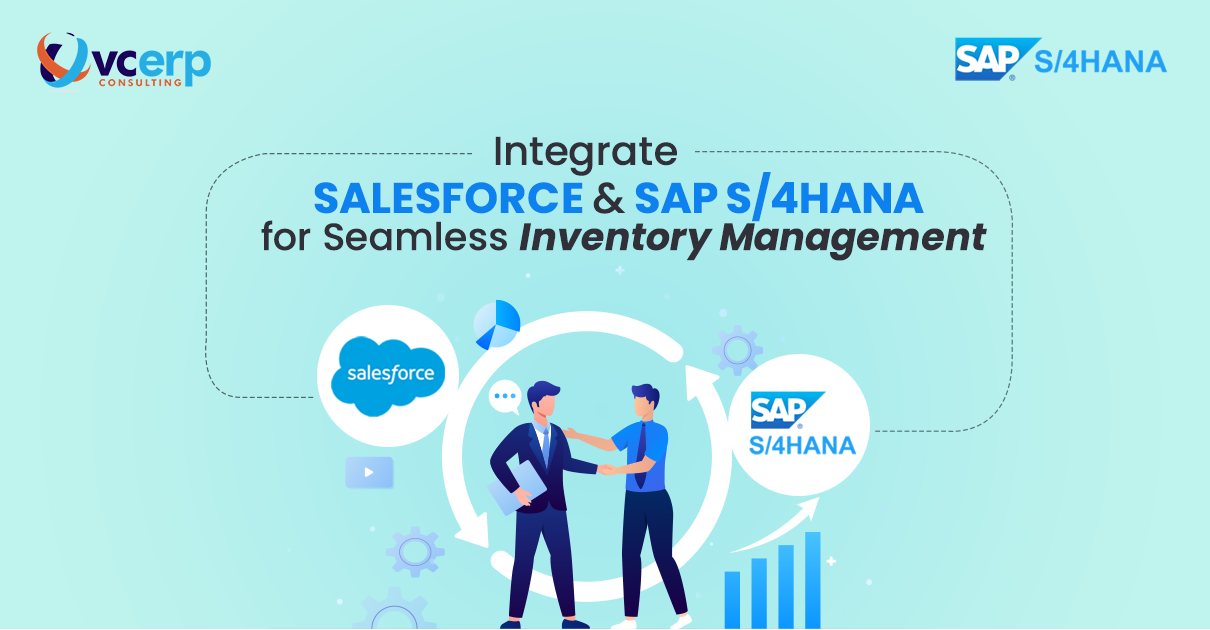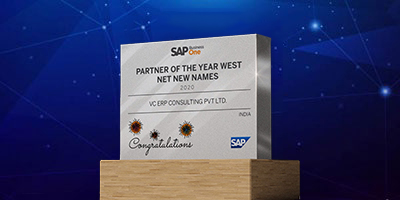
In today’s open global economy, efficient inventory management is no longer a luxury; it’s a necessity. Retailers face the constant challenge of balancing customer demand with maintaining optimal stock levels. Stockouts lead to dissatisfied customers and lost sales opportunities, while excess inventory can tie up valuable resources and erode profitability.
This article explores the concept of seamless inventory management and its critical role in retail success. We will understand how integrating two industry-leading platforms, Salesforce and SAP S/4HANA enables retailers with a unified view of their inventory and streamlined supply chain.
Traditionally, retailers have struggled with siloed data between customer relationship management (CRM) and enterprise resource planning (ERP) systems. This disconnect creates significant challenges in maintaining accurate and real-time inventory visibility. Sales associates often lack access to up-to-date stock levels, leading to customer frustration and missed sales opportunities.
VC ERP the best integration partner in Ahmedabad facilitates this gap by seamlessly integrating your Salesforce & SAP S/4HANA. This allows for:
- Real-time Inventory Visibility
- Streamlined Order Fulfillment
- Data-Driven Decision-Making
- Enhanced Customer Experience
Also Read:
What is SAP S/4HANA Integration with Salesforce?Why Integrate your ERP and CRM?
Siloed data doesn’t cut it and for optimal efficiency and a holistic view of your operations, integrating your Enterprise Resource Planning (ERP) and Customer Relationship Management (CRM) systems is a strategic move.
An ERP system acts as the central nervous system of your back-office operations, managing everything from inventory and production to financials and accounting. On the other hand, a CRM focuses on the front office, nurturing customer relationships by tracking interactions, sales opportunities, and service requests.
While both ERP and CRM are crucial for business success, keeping them disconnected can lead to:
- Critical information gets trapped within each system giving rise to data silos and hindering a complete view of your customers and operations.
- Duplicate data entry, manual workflows, and delays in processes.
- Inaccurate Decision-Making without a unified view
Integrating ERP and CRM software creates a unified platform for seamless data exchange for a company. Let’s understand with an example of how integrating SAP S/4HANA and Salesforce unites different business processes and brings a 360-degree view in hand.
Example
Let’s take the example of Acme Dyeing in the textile industry, a leading chemical dyeing facility that needs to ensure a steady supply of specific dyes to maintain production. The production manager uses a web application connected to Salesforce to review upcoming customer orders and their corresponding dye requirements.
Process
The dye requirement data or the demand for dyes in the market from customers seamlessly flows from Salesforce to SAP S/4HANA through a secure integration. SAP S/4HANA receives the data and checks the current inventory level of the specific dyes. Then either of the two scenarios occur, either its sufficient inventory or low inventory.
Possible Scenarios
1. Sufficient Inventory
- If there are enough dyes in stock, SAP S/4HANA allocates the requested quantities to the upcoming production orders.
- An inventory update is sent back to Salesforce, notifying the production manager that the dyes are available.
- In Salesforce, the production manager can then schedule the allocation of these dyes to specific dyeing batches.
2. Low Inventory
- If SAP S/4HANA identifies insufficient stock of a particular dye, an alert is generated to warn of a potential shortage.
- Depending on pre-configured settings, SAP S/4HANA might automatically trigger a purchase order for the needed dye from pre-approved vendors.
- Alternatively, an alert is sent to the procurement department within Acme Dyeing (gold arrow), prompting them to initiate the restocking process.
- Regardless of the inventory situation in SAP S/4HANA, the production manager receives a notification regarding dye availability for upcoming orders.
- Once the order is confirmed (either through automatic allocation or manual restocking), the manager can schedule the allocation of the dyes to specific batches within Salesforce.
The Final Steps
- The necessary dyes are retrieved from the warehouse and allocated to the designated dyeing batches.
- Warehouse personnel can update the inventory levels within SAP S/4HANA upon completing the allocation.
- The production team can then proceed with the dyeing process using the allocated dyes.
This example showcases that the power of integrating Salesforce and SAP S/4HANA for inventory management in a chemical dyeing factory resulted in
Real-time Data
Both platforms share real-time data, allowing the production manager to make informed decisions about dye inventory and production scheduling.
Streamlined Workflow
The integration automates data exchange, minimizing manual work and potential errors in order fulfilment.
Inventory Optimization
Automatic alerts for low stock and potential purchase orders help avoid production delays and ensure efficient use of resources.
Improved Visibility
Production managers gain a holistic view of inventory levels within a single system, facilitating better planning and allocation of dyes.
From Salesforce to SAP;Benefits of Integration For Inventory Management
Traditionally, customer relationship management (CRM) systems like Salesforce and enterprise resource planning (ERP) systems like SAP S/4HANA have functioned as separate entities. This results in data silos, hindering real-time visibility and ultimately efficient inventory management.
However, integrating these systems brings a treasure of benefits that can revolutionize your stock management. Let’s take a look at some key advantages –
Real-time Inventory Visibility
Your sales team can have access to accurate, up-to-the-minute inventory levels directly within Salesforce. Additionally, integration eliminates the need for manual checks or outdated reports making sure that your sales reps make informed decisions and provide accurate quotes and delivery timelines to customers.
Advanced Stock Management Capabilities
Go beyond basic stock levels. Integration allows you to use SAP’s advanced functionalities for managing inventory by item type, location, or even specific lot numbers. This control helps optimize storage space, minimize stockouts and ensure you always have the right products.
Material Requirements Planning (MRP) Integration
Effortlessly align your sales forecasts with production planning. Integrating MRP with Salesforce data, you can automatically generate accurate production forecasts based on real-time sales trends. This helps prevent overstocking or understocking, ensuring a smooth production flow and efficient use of resources.
Goods Movement Automation
Say goodbye to manual data entry for tasks like order fulfilment and shipment processing. Integration streamlines these processes, automatically updating inventory levels in SAP as soon as an order is confirmed in Salesforce. This reduces human error, saves valuable time and allows your team to focus on higher-value tasks.
Serial Number Management
Different businesses have different methods when it comes to batch vs serialization of stock. When Dealing with serialized items, integration offers a powerful advantage. Track individual items throughout your supply chain from purchase to sale within a unified system. This improves traceability and simplifies product recalls if necessary also provides valuable insights into /product lifecycles.
Integrating Salesforce and SAP S/4HANA can seem like a complex undertaking. However, partnering with the right expert can make all the difference. This is where VC ERP steps in.
VC ERP; Your Trusted SAP S/4HANA and Salesforce Integration Partner
VC ERP is the leading SAP S/4HANA implementation partner with a deep understanding of both Salesforce and SAP S/4HANA. Consultants at VC ERP possess the expertise and perform the best practices to integrate SAP S/4HANA and Salesforce ensuring that companies can reap full benefits of the integration.
Enhancing Functionality and Efficiency
VC ERP goes beyond simply connecting your systems. They take a holistic approach, meticulously analyzing your specific business needs and workflows. This allows them to:
Customize the Integration
Experts tailor the integration to seamlessly fit your existing processes. Whether you require real-time data synchronization or bi-directional updates, they configure the system to optimize efficiency.
Data Mapping and Cleansing
Accurate data is the foundation of a successful integration. VC ERP ensures clean and consistent data flows between Salesforce and SAP S/4HANA, eliminating discrepancies and ensuring reliable information is always available.
Ongoing Support
Integration is an ongoing process. VC ERP provides ongoing support to ensure your systems remain integrated and continue to deliver value as your business evolves.
Partnering with VC ERP you gain access to their expertise, ensuring a smooth and successful integration that helps you with the full potential of your Salesforce and SAP S/4HANA systems. Contact us now and schedule a free consultation!







